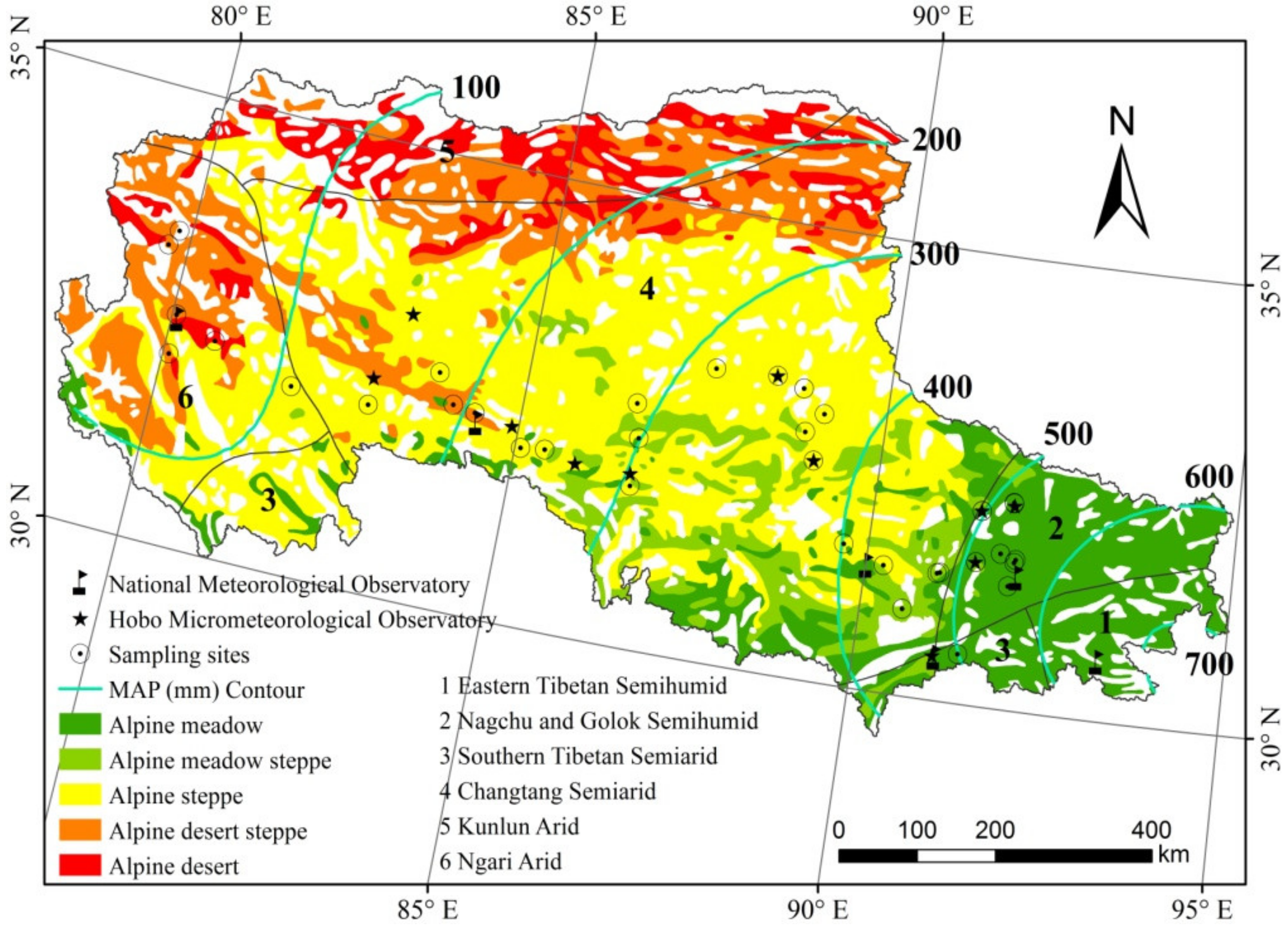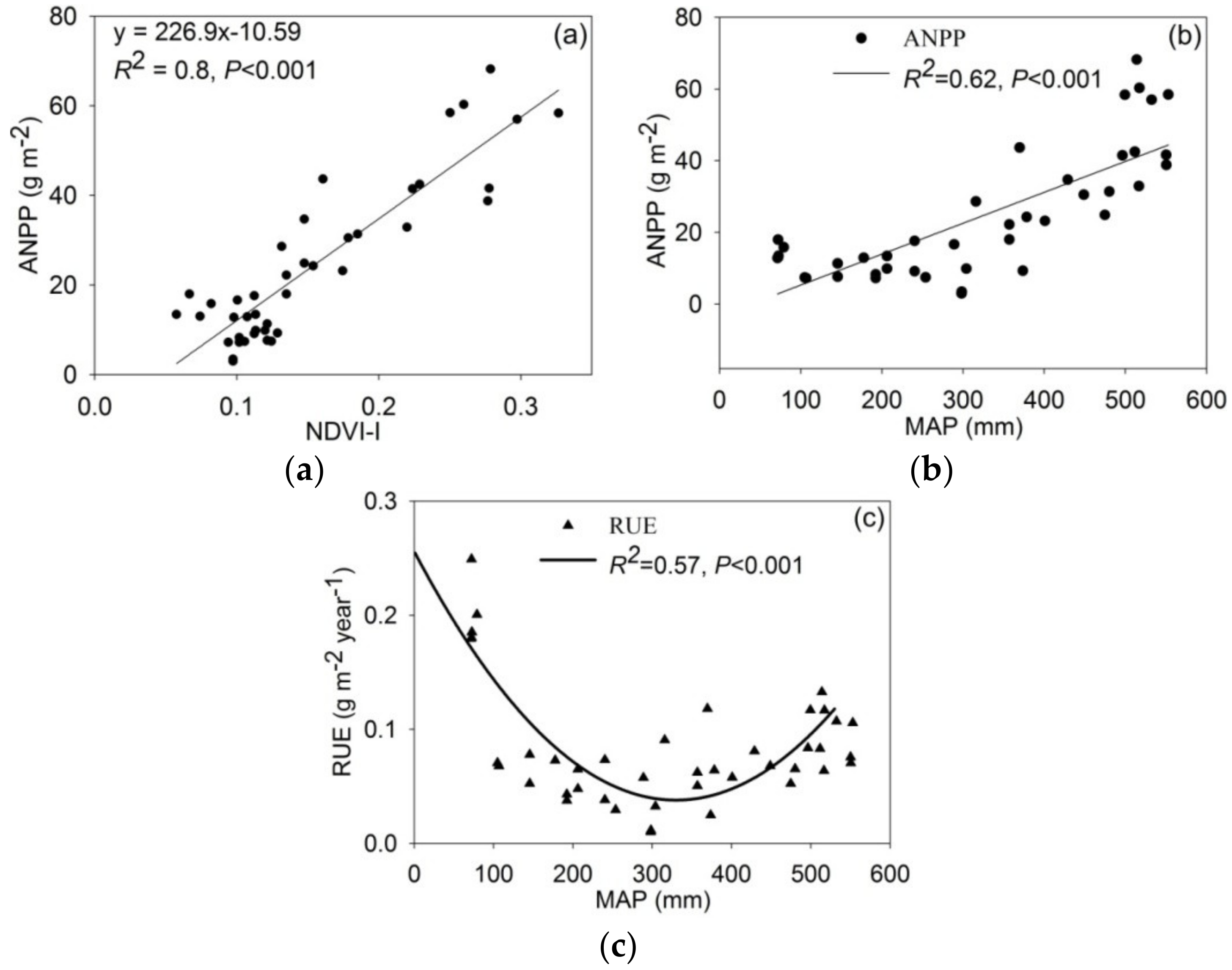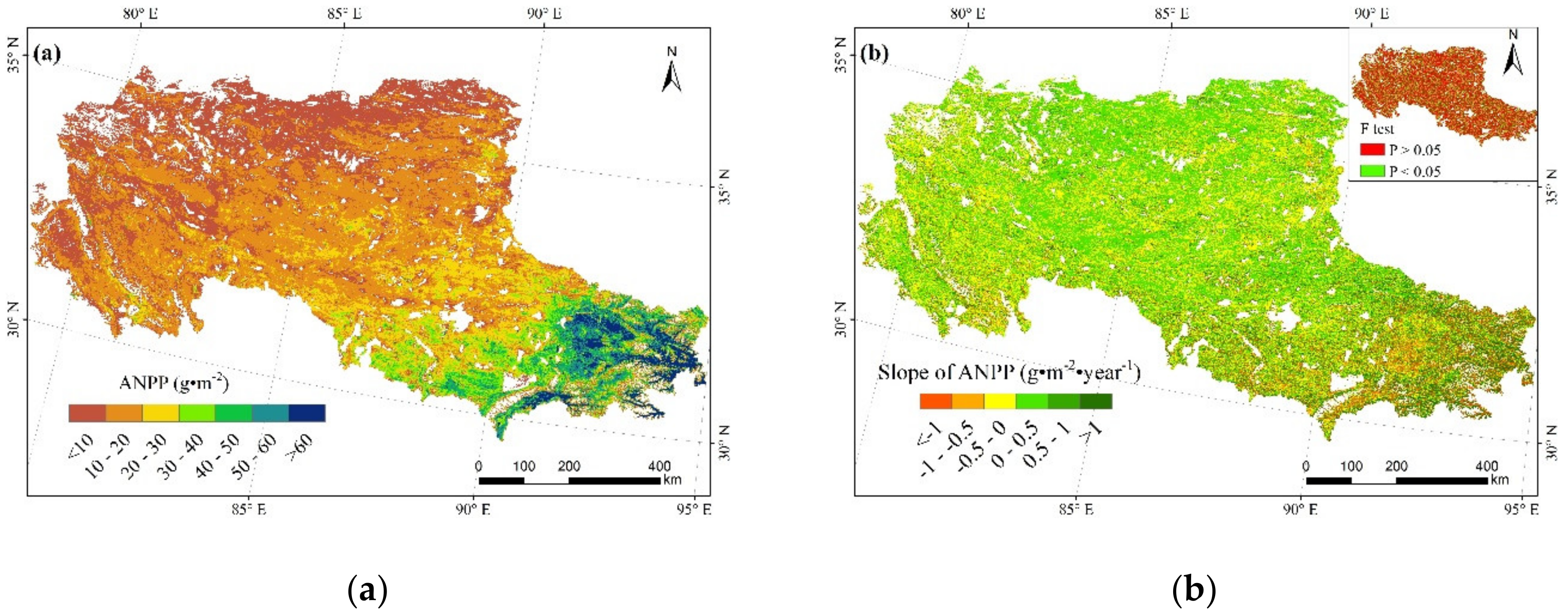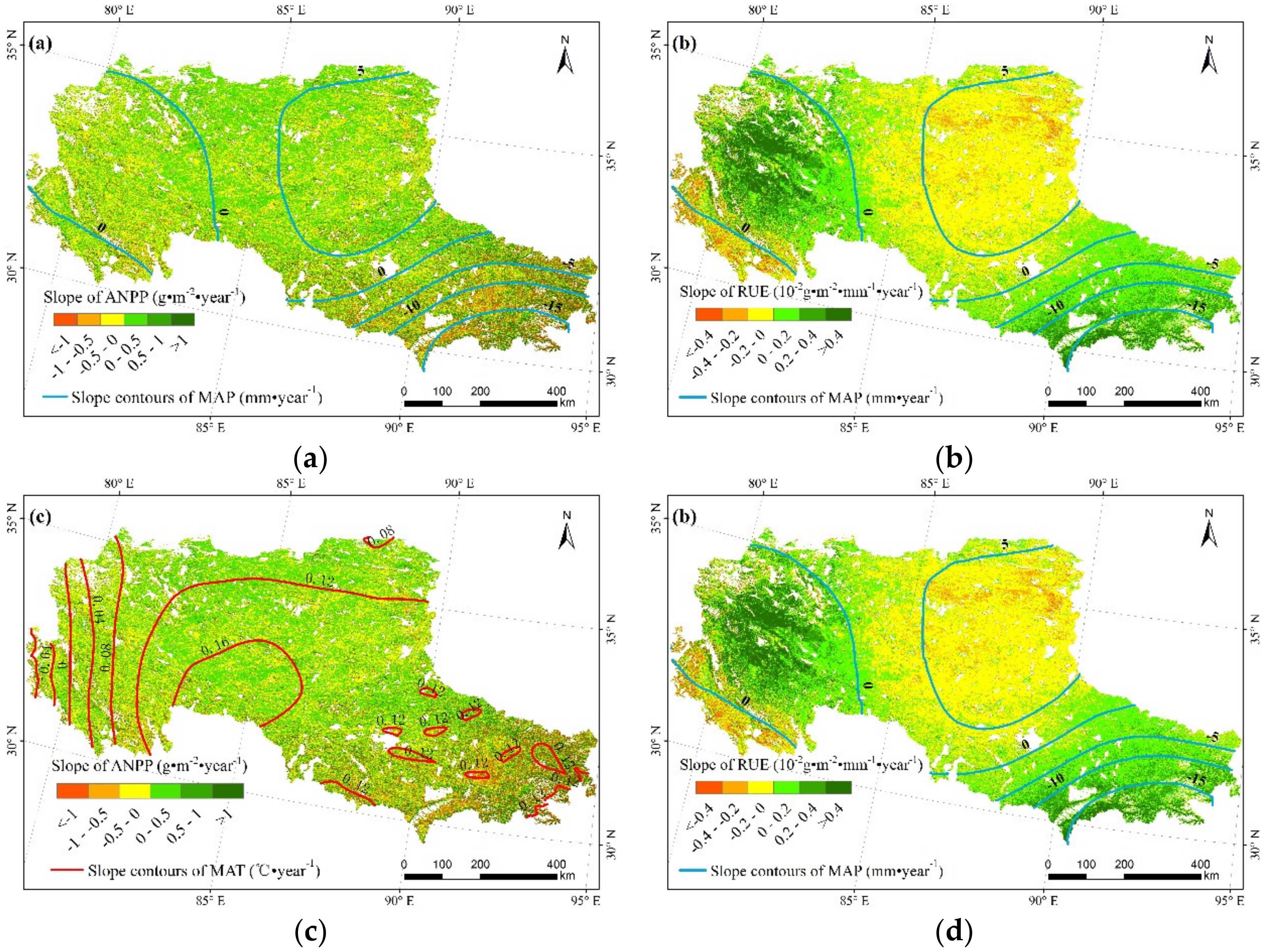Spatial–Temporal Variation of ANPP and Rain-Use Efficiency Along a Precipitation Gradient on Changtang Plateau, Tibet
Abstract
:1. Introduction
2. Materials and Methods
2.1. Study Area
2.2. Data Acquisition
2.2.1. ANPP Calculation
2.2.2. Sampling and Meteorological Data
2.2.3. RUE Calculation
2.2.4. Calculation of the Spatial and Temporal Variation of ANPP and RUE
3. Results
3.1. Relationship between Measured ANPP and NDVI-I
3.2. Spatial–Temporal Patterns of ANPP on the Changtang Plateau
3.3. Spatial–Temporal Patterns of RUE on the Changtang Plateau
3.4. Influence of Climate Change on Temporal Patterns of ANPP and RUE
4. Discussion
4.1. The Spatial Variation of ANPP and RUE
4.2. The Interannual Variation of ANPP and RUE and Its Relationship with Climate Change
5. Conclusions
Author Contributions
Funding
Acknowledgments
Conflicts of Interest
References
- Austin, A.T.; Sala, O.E. Carbon and nitrogen dynamics across a natural precipitation gradient in Patagonia, Argentina. J. Veg. Sci. 2002, 13, 351–360. [Google Scholar] [CrossRef]
- Jobbágy, E.G.; Sala, O.E.; Paruelo, J.M. Patterns and controls of primary production in the Patagonian Steppe. Ecology 2002, 83, 307–319. [Google Scholar]
- Lauenroth, W. Grassland Primary Production: North American Grasslands in Perspective. In Perspectives in Grassland Ecology; Ecological Studies; Springer: New York, NY, USA, 1979; pp. 3–24. [Google Scholar]
- Epstein, H.E.; Burke, I.C.; Lauenroth, W.K. Regional patterns of decomposition and primary production rates in the US Great Plains. Ecology 2002, 83, 320–327. [Google Scholar]
- McNaughton, S.J.; Sala, O.E.; Oesterheld, M. Comparative ecology of African and South American arid to subhumid ecosystems. In Biological Relationships between Africa and South America; Yale University Press: New Haven, CN, USA, 1993; pp. 548–567. [Google Scholar]
- Scanlon, T.M.; Albertson, J.D.; Caylor, K.K.; Williams, C.A. Determining land surface fractional cover from NDVI and rainfall time series for a savanna ecosystem. Remote Sens. Environ. 2002, 82, 376–388. [Google Scholar] [CrossRef]
- Lauenroth, W.K.; Sala, O.E. Long-Term Forage Production of North American Shortgrass Steppe. Ecol. Appl. 1992, 2, 397–403. [Google Scholar] [CrossRef] [PubMed]
- Paruelo, J.M.; Epstein, H.E.; Lauenroth, W.K.; Burke, I.C. ANPP Estimates from NDVI for the Central Grassland Region of the United States. Ecology 1997, 78, 953–958. [Google Scholar] [CrossRef]
- Paruelo, J.M.; Lauenroth, W.K.; Burke, I.C.; Sala, O.E. Grassland precipitation-use efficiency varies across a resource gradient. Ecosystems 1999, 2, 64–68. [Google Scholar] [CrossRef]
- Briggs, J.M.; Knapp, A.K. Interannual variability in primary production in tallgrass prairie: Climate, soil moisture, topographic position, and fire as determinants of aboveground biomass. Am. J. Bot. 1995, 82, 1024–1030. [Google Scholar] [CrossRef]
- Fabricante, I.; Oesterheld, M.; Paruelo, J.M. Annual and seasonal variation of NDVI explained by current and previous precipitation across Northern Patagonia. J. Arid Environ. 2009, 73, 745–753. [Google Scholar] [CrossRef]
- Fang, J.; Piao, S.; Tang, Z.; Peng, C.; Ji, W. Interannual Variability in Net Primary Production and Precipitation. Science 2001, 293, 1723. [Google Scholar] [CrossRef]
- Bai, Y.; Wu, J.; Xing, Q.; Pan, Q.M.; Huang, J.H.; Yang, D.L.; Han, X.G. Primary production and rain use efficiency across a precipitation gradient on the Mongolia Plateau. Ecology 2008, 89, 2140–2153. [Google Scholar] [CrossRef] [PubMed]
- Huxman, T.E.; Smith, M.D.; Fay, P.A.; Knapp, A.K.; Shaw, M.R.; Loik, M.E.; Smith, S.D.; Tissue, D.T.; Zak, J.C.; Weltzi, J.F.; et al. Convergence across biomes to a common rain-use efficiency. Nature 2004, 429, 651–654. [Google Scholar] [CrossRef] [PubMed]
- Hu, Z.; Yu, G.R.; Fan, J.W.; Zhong, H.P.; Wang, S.Q.; Li, S.G. Precipitation-use efficiency along a 4500-km grassland transect. Glob. Ecol. Biogeogr. 2010, 19, 842–851. [Google Scholar]
- Le Houérou, H.N. Rain use efficiency: A unifying concept in arid-land ecology. J. Arid Environ. 1984, 7, 213–247. [Google Scholar]
- Lauenroth, W.K.; Burke, I.C.; Paruelo, J.M. Patterns of Production and Precipitation-Use Efficiency of Winter Wheat and Native Grasslands in the Central Great Plains of the United States. Ecosystems 2000, 3, 344–351. [Google Scholar] [CrossRef]
- Angert, A.; Biraud, S.; Bonfils, C.; Henning, C.C.; Buermann, W.; Pinzon, J.; Tucker, C.J.; Fung, I. Drier summers cancel out the CO2 uptake enhancement induced by warmer springs. Proc. Natl. Acad. Sci. USA 2005, 102, 10823–10827. [Google Scholar] [CrossRef] [PubMed]
- Easterling, D.R.; Meehl, G.A.; Parmesan, C.; Changnon, S.A.; Karl, T.R.; Mearns, L.O. Climate extremes: Observations, modeling, and impacts. Science 2000, 289, 2068–2074. [Google Scholar] [CrossRef]
- Knapp, A.K.; Fay, P.A.; Blair, J.M.; Collins, S.L.; Smith, M.D.; Carlisle, J.D.; Harper, C.W.; Danner, B.T.; Lett, M.S.; McCarron, J.K. Rainfall Variability, Carbon Cycling, and Plant Species Diversity in a Mesic Grassland. Science 2002, 298, 2202–2205. [Google Scholar] [CrossRef]
- Kato, T.; Tang, Y.H.; Gu, S.; Cui, X.Y.; Hirota, M.; Du, M.Y.; Li, Y.N.; Zhao, X.Q.; Oikawa, T. Carbon dioxide exchange between the atmosphere and an alpine meadow ecosystem on the Qinghai–Tibetan Plateau, China. Agric. For. Meteorol. 2004, 124, 121–134. [Google Scholar] [CrossRef]
- Piao, S.; Fang, J.; He, J. Variations in vegetation net primary production in the Qinghai-Xizang Plateau, China, from 1982 to 1999. Clim. Chang. 2006, 74, 253–267. [Google Scholar] [CrossRef]
- Mi, Z.; Chen, L.; Zhang, Z.; He, J. Alpine grassland water use efficiency based on annual precipitation, growing season precipitation and growing season evapotranspiration. Chin. J. Plant. Ecol. 2015, 39, 649–660. [Google Scholar]
- Qiu, J.; Zhang, H.; Shen, W. Spatial characteristics of precipitation use efficiency on the Qinghai-Tibet Plateau from 1982 to 2007. Nat. Sci. 2014, 53, 126–133. [Google Scholar]
- Ye, H.; Wang, J.; Huang, M.; Qi, S. Spatial pattern of vegetation precipitation use efficiency and its response to precipitation and temperature on the Qinghai-Xizang Plateau of China. Chin. J. Plant. Ecol. 2012, 36, 1237–1247. [Google Scholar] [CrossRef]
- Yang, Y.; Fang, J.; Fay, P.A.; Bell, J.E.; Ji, C. Rain use efficiency across a precipitation gradient on the Tibetan Plateau. Geophys. Res. Lett. 2010, 37, L15702. [Google Scholar] [CrossRef]
- Le Houérou, H.N.; Bingham, R.L.; Skerbek, W. Relationship between the variability of primary production and the variability of annual precipitation in world arid lands. J. Arid Environ. 1988, 15, 1–18. [Google Scholar]
- Hector, A.; Schmid, B.; Beierkuhnlein, C.; Caldeira, M.C.; Diemer, M.; Dimitrakopoulos, P.G.; Finn, J.A.; Freitas, H.; Giller, P.S.; Good, J.; et al. Plant Diversity and Productivity Experiments in European Grasslands. Science 1999, 286, 1123–1127. [Google Scholar] [CrossRef] [PubMed]
- Tilman, D. The Influence of Functional Diversity and Composition on Ecosystem Processes. Science 1997, 277, 1300–1302. [Google Scholar] [CrossRef]
- Sala, O.E.; Gherardi, L.A.; Reichmann, L.; Jobbágy, E.; Peters, D. Legacies of precipitation fluctuations on primary production: Theory and data synthesis. Philos. Trans. R. Soc. Lond. Ser. B Biol. Sci. 2012, 367, 3135–3144. [Google Scholar] [CrossRef]
- Jobbágy, E.G.; Paruelo, J.M.; León, R.J.C. Vegetation heterogeneity and diversity in flat and mountain landscapes of Patagonia (Argentina). J. Veg. Sci. 1996, 7, 599–608. [Google Scholar]
- Knapp, A.K.; Smith, M.D. Variation Among Biomes in Temporal Dynamics of Aboveground Primary Production. Science 2001, 291, 481–484. [Google Scholar] [CrossRef]
- Li, M. Soil characteristics and use of the Changtang Plateau. Nat. Resour. 1980, 4, 60–69. [Google Scholar]
- Li, M. Rational exploitation of grassland resources in the Northern Xizang Plateau. J. Nat. Resour. 2000, 15, 335–339. [Google Scholar]
- Wu, J.; Shen, Z.; Zhang, X. Precipitation and species composition primarily determine the diversity–productivity relationship of alpine grasslands on the Northern Tibetan Plateau. Alpine Bot. 2014, 124, 13–25. [Google Scholar] [CrossRef]
- Bella, C.M.D.; Negri, I.J.; Posse, G.; Jaimes, F.R.; Jobbágy, E.G.; Garbulsky, M.F.; Deregibus, V.A. Forage Production of the Argentine Pampa Region Based on Land Use and Long-Term Normalized Difference Vegetation Index Data. Rangel. Ecol. Manag. 2009, 62, 163–170. [Google Scholar] [CrossRef]
- Jiao, C.; Yu, G.R.; Ge, J.P.; Chen, X.; Zhang, C.; He, N.P.; Chen, Z.; Hu, Z.M. Analysis of spatial and temporal patterns of aboveground net primary productivity in the Eurasian steppe region from 1982 to 2013. Ecol. Evol. 2017, 7, 5149–5162. [Google Scholar] [CrossRef] [PubMed]
- Liu, S.; Cheng, F.; Dong, S.; Zhao, H.; Hou, X.; Wu, X. Spatiotemporal dynamics of grassland aboveground biomass on the Qinghai-Tibet Plateau based on validated MODIS NDVI. Sci. Rep. 2017, 7, 4182. [Google Scholar] [CrossRef] [PubMed]
- Yu, H.; Luedeling, E.; Chapin, J.X.S. Winter and spring warming result in delayed spring phenology on the Tibetan Plateau. Proc. Natl. Acad. Sci. USA 2010, 107, 22151–22156. [Google Scholar] [CrossRef]
- Ding, M.; Zhang, Y.L.; Sun, X.M.; Liu, L.S.; Wang, Z.F.; Bai, W.Q. Spatiotemporal variation in alpine grassland phenology in the Qinghai-Tibetan Plateau from 1999 to 2009. Chin. Sci. Bull. 2013, 58, 396–405. [Google Scholar] [CrossRef]
- Zhang, G.; Zhang, Y.J.; Dong, J.W.; Xiao, X.M. Green-up dates in the Tibetan Plateau have continuously advanced from 1982 to 2011. Proc. Natl. Acad. Sci. USA 2013, 110, 4309–4314. [Google Scholar] [CrossRef] [PubMed]
- Shen, M.; Piao, S.L.; Cong, N.; Zhang, G.X.; Jassens, I.A. Precipitation impacts on vegetation spring phenology on the Tibetan Plateau. Glob. Chang. Biol. 2015, 21, 3647–3656. [Google Scholar] [CrossRef] [PubMed]
- Sellers, P.J.; Berry, J.A.; Collatz, G.J.; Field, C.B.; Hall, F.G. Canopy reflectance, photosynthesis, and transpiration. III. A reanalysis using improved leaf models and a new canopy integration scheme. Remote Sens. Environ. 1992, 42, 187–216. [Google Scholar] [CrossRef]
- Paruelo, J.M.; Burke, I.C.; Lauenroth, W.K. Land-use impact on ecosystem functioning in eastern Colorado, USA. Glob. Chang. Biol. 2010, 7, 631–639. [Google Scholar]
- Didan, K. MOD13Q1 MODIS/Terra Vegetation Indices 16-Day L3 Global 250m SIN Grid V006. NASA EOSDIS LP DAAC 2015. [Google Scholar] [CrossRef]
- Running, S.; Mu, Q.; Zhao, M. MOD17A3H MODIS/Terra Net Primary Production Yearly L4 Global 500m SIN Grid V006. NASA EOSDIS Land Processes DAAC 2015. [Google Scholar] [CrossRef]
- McNaughton, S.J. Ecology of a Grazing Ecosystem: The Serengeti. Ecol. Monogr. 1985, 55, 259–294. [Google Scholar] [CrossRef]
- Grime, J.P. Evidence for the Existence of Three Primary Strategies in Plants and Its Relevance to Ecological and Evolutionary Theory. Am. Nat. 1977, 111, 1169. [Google Scholar] [CrossRef]
- Epstein, H.E.; Paruelo, J.M.; Pineiro, G.; Burke, I.C.; Lauenroth, W.K.; Barrett, J.E. Interactions of water and nitrogen on primary productivity across spatial and temporal scales in grassland and shrubland ecosystems. In Dryland Ecohydrology; Springer: Dordrecht, The Netherlands, 2006; pp. 201–216. [Google Scholar]
- Ogaya, R.; Peñuelas, J. Comparative field study of Quercus ilex and Phillyrea latifolia: Photosynthetic response to experimental drought conditions. Environ. Exp. Bot. 2003, 50, 137–148. [Google Scholar] [CrossRef]
- Wei, H.; Wu, B.; Yang, W.; Luo, T. Low rainfall-induced shift in leaf trait relationship within species along a semi-arid sandy land transect in northern China. Plant. Biol. 2011, 13, 85–92. [Google Scholar] [CrossRef] [PubMed]
- Hu, M.; Zhang, L.; Luo, T.; Shen, W. Variations in leaf functional traits of Stipa purpurea along a rainfall gradient in Xizang, China. Chin. J. Plant. Ecol. 2012, 36, 136–143. [Google Scholar] [CrossRef]
- Zhao, G.S.; Xiong, D.P.; Shi, P.L.; Feng, Y.F.; Wu, J.S.; Zhang, X.Z.; Zeng, Z.X. Leaf nitrogen resorption efficiency of Stipapurpurea and its determinants along aprecipitation gradient on the Changtang Plateau. Acta Ecol. Sinica 2016, 36, 3419–3428. [Google Scholar]
- Zhao, G.; Shi, P.; Wu, J.; Xiong, D.; Zong, N.; Zhang, X. Foliar nutrient resorption patterns of four functional plants along a precipitation gradient on the Tibetan Changtang Plateau. Ecol. Evol. 2017, 7, 7201–7212. [Google Scholar] [CrossRef] [PubMed]
- Veron, S.R.; Paruelo, J.M.; Sala, O.E.; Lauenroth, W.K. Environmental Controls of Primary Production in Agricultural Systems of the Argentine Pampas. Ecosystems 2002, 5, 625–635. [Google Scholar] [CrossRef]
- Yang, Y.H.; Rao, S.; Hu, H.F.; Chen, A.P.; Ji, C.J.; Zhu, B.; Zuo, W.Y.; Li, X.R.; Shen, H.H.; Wang, Z.H.; Tang, Y.H.; Fang, J.Y. Plant species richness of alpine grasslands in relation to environmental factors and biomass on the Tibetan Plateau. Biodivers. Sci. 2004, 12, 200–205. [Google Scholar]
- Farquhar, G.; O’Leary, M.; Berry, J. On the Relationship Between Carbon Isotope Discrimination and the Intercellular Carbon Dioxide Concentration in Leaves. Funct. Plant. Biol. 1982, 9, 121–137. [Google Scholar] [CrossRef]
- Zhang, X.; Lu, X.; Wang, X. Spatial-Temporal NDVI Variation of Different Alpine Grassland Classes and Groups in Northern Tibet from 2000 to 2013. Mount. Res. Dev. 2015, 35, 254–263. [Google Scholar] [CrossRef]
- Peters, D.P.C.; Yao, J.; Sala, O.E.; Anderson, J.P. Directional climate change and potential reversal of desertification in arid and semiarid ecosystems. Glob. Chang. Biol. 2012, 18, 151–163. [Google Scholar] [CrossRef]
- Grime, J.; Thompson, K.; Hunt, R.; Hodgson, J.G.; Cornelissen, J.H.C.; Rorison, I.H.; Hendry, G.A.F.; Ashenden, T.W.; Askew, A.P.; Band, S.R.; et al. Integrated Screening Validates Primary Axes of Specialisation in Plants. Oikos 1997, 79, 259–281. [Google Scholar] [CrossRef]
- Keddy, P.A. A Pragmatic Approach to Functional Ecology. Funct. Ecol. 1992, 6, 621–626. [Google Scholar] [CrossRef]
- Aguiar, M.R.; Sala, O.E. Competition, facilitation, seed distribution and the origin of patches in a Patagonian Steppe. Oikos 1994, 70, 26–34. [Google Scholar] [CrossRef]
- Lauenroth, W.K.; Sala, O.E.; Coffin, D.P.; Kirchner, B.T. The importance of soil water in the recruitment of Bouteloua gracilis in the shortgrass steppe. Ecol. Appl. 1994, 4, 741–749. [Google Scholar] [CrossRef]
- Collins, S.L.; Koerner, S.E.; Plaut, J.A.; Okie, J.G.; Brese, D.; Calabrese, L.B.; Carvajal, A.; Evansen, R.J.; Nonaka, E. Stability of tallgrass prairie during a 19-year increase in growing season precipitation. Funct. Ecol. 2012, 26, 1450–1459. [Google Scholar] [CrossRef]
- Evans, S.E.; Byrne, K.M.; Lauenroth, W.K.; Burke, I.C. Defining the limit to resistance in a drought-tolerant grassland: Long-term severe drought significantly reduces the dominant species and increases ruderals. J. Ecol. 2011, 99, 1500–1507. [Google Scholar] [CrossRef]





| Grassland Type | Dominant Species | Life Forms |
|---|---|---|
| Alpine meadow | Kobresiapygmaea, K. humilis, and Carexmoorcroftii | perennial herb |
| Alpine meadow steppe | Kobresiapygmaea, Carexmoorcroftii, and Stipapurpurea | perennial herb |
| Alpine steppe | S. purpurea, S. capillacea, and S. subsessiliflora var. basiplumosa | perennial herb |
| Alpine desert steppe | S. purpurea, S. glareosa, and Ceratoideslatens | perennial herb, subshrub |
| Alpine desert | Ceratoideslatens and Ajaniafruticolosa | subshrub |
| Climate Zone | Mean Annual Precipitation (MAP, mm) | Average Temperature in August (℃) |
|---|---|---|
| Eastern Tibetan semihumid | 600 | 13–16 |
| Nagchu and Golok semihumid | 400–700 | 8–10 |
| Southern Tibetan semiarid | 400 | 10–15 |
| Changtang semiarid | 100–300 | 6–10 |
| Kunlun arid | 100 | < 6 |
| Ngari arid | 50–100 | 10–12 |
| NDVI-I | In-situ ANPP | MODIS NPP | MAP | |
|---|---|---|---|---|
| NDVI-I | 1 | 0.90 ** | 0.98 ** | 0.87 ** |
| In-situ ANPP | 1 | 0.84 ** | 0.79 ** | |
| MODIS NPP | 1 | 0.84 ** | ||
| MAP | 1 |
| Region | ANPP ± SD (g·m−2) | ANPP Slope ± SD (g·m−2·year−1) | Uptrend (p < 0.05) (%) | Downtrend (p < 0.05) (%) | |
|---|---|---|---|---|---|
| Grassland type | Alpine meadow | 38.79 ± 19.83 | 0.06 ± 1.49 | 9.03 (2.93) | 8.59 (2.95) |
| Alpine meadow steppe | 25.79 ± 11.09 | 0.02 ± 0.85 | 5.15 (1.76) | 4.36 (1.43) | |
| Alpine steppe | 15.75 ± 6.78 | 0.01 ± 0.58 | 25.2 (8.49) | 21.39 (6.97) | |
| Alpine desert steppe | 9.88 ± 5.28 | 0.03 ± 0.46 | 10.27 (3.5) | 7.6 (2.34) | |
| Alpine desert | 8.1 ± 4.63 | 0.05 ± 0.47 | 5.2 (1.83) | 3.2 (0.94) | |
| Climate zone | Eastern Tibetan semihumid | 44.62 ± 27.65 | 0.23 ± 2.37 | 1.79 (0.56) | 1.39 (0.46) |
| Nagchu and Golok semihumid | 44.07 ± 17.3 | −0.02 ± 1.42 | 3.54 (1.18) | 3.75 (1.31) | |
| Southern Tibetan semiarid | 24.29 ± 18.96 | −0.02 ± 1.28 | 2.18 (0.7) | 2.58 ( 0.91) | |
| Changtang semiarid | 17.11 ± 9.26 | 0.02 ± 0.66 | 33.55 (11.5) | 26.66 (8.56) | |
| Kunlun arid | 6.64 ± 3.65 | 0.07 ± 0.4 | 7.5 (2.63) | 3.94 (1.03) | |
| Ngari arid | 10.75 ± 5.98 | −0.01 ± 0.57 | 6.39 (2.11) | 6.73 (2.33) |
| Region | RUE ± SD (g·m−2·mm−1) | RUE Slope ± SD (10−2g·m−2·mm−1·year−1) | Uptrend (p < 0.05) (%) | Downtrend (p < 0.05) (%) | |
|---|---|---|---|---|---|
| Grassland type | Alpine meadow | 0.08 ± 0.04 | 0.14 ± 0.19 | 14.66 (6.57) | 2.96 (0.12) |
| Alpine meadow steppe | 0.07 ± 0.03 | 0.03 ± 0.16 | 5.18 (1.97) | 4.33 (0.74) | |
| Alpine steppe | 0.08 ± 0.05 | 0 ± 0.22 | 18.29 (1.69) | 28.31 (6.36) | |
| Alpine desert steppe | 0.09 ± 0.07 | 0.03 ± 0.34 | 7.92 (0.49) | 9.95(0.69) | |
| Alpine desert | 0.07 ± 0.06 | 0.02 ± 0.28 | 3.45 (0.24) | 4.95 (0.32) | |
| Climate zone | Eastern Tibetan semihumid | 0.07 ± 0.04 | 0.2 ± 0.18 | 2.74 (1.63) | 0.44 (0) |
| Nagchu and Golok semihumid | 0.08 ± 0.03 | 0.12 ± 0.13 | 6.23 (2.32) | 1.05 (0.02) | |
| Southern Tibetan semiarid | 0.1 ± 0.06 | 0.08 ± 0.34 | 2.82 (1.42) | 1.92 (0.17) | |
| Changtang semiarid | 0.07 ± 0.03 | −0.01 ± 0.18 | 24.77 (4.48) | 35.49 (7.26) | |
| Kunlun arid | 0.06 ± 0.04 | −0.01 ± 0.19 | 4.74 (0.25) | 6.7 (0.2) | |
| Ngari arid | 0.15 ± 0.08 | 0.17 ± 0.48 | 8.78 (0.59) | 4.33 (0.14) |
| Region | MAP (mm·year−1) | Uptrend (p < 0.05) (%) | Downtrend (p < 0.05) (%) | MAT (°C·year−1) | Uptrend (p < 0.05) (%) | Downtrend (p < 0.05) (%) | |
|---|---|---|---|---|---|---|---|
| Grassland type | Alpine meadow | −8.54 ± 5.86 | 1 (0.03) | 16.75 (9.85) | 0.13 ± 0.03 | 17.39 (17.09) | 0.34 (0) |
| Alpine meadow steppe | −1.04 ± 5.89 | 4.78 (1.34) | 4.40 (1.79) | 0.14 ± 0.01 | 9.19 (9.19) | 0 | |
| Alpine steppe | 2.12 ± 3.79 | 26.65 (12.68) | 19.22 (0.27) | 0.13 ± 0.04 | 45.24 (38.79) | 0.64 (0) | |
| Alpine desert steppe | 1.42 ± 3.48 | 9.28 (0.93) | 9.07 (0.02) | 0.09 ± 0.06 | 16.38 (9.95) | 1.97 (0) | |
| Alpine desert | 2.3 ± 2.98 | 5.92 (0.21) | 2.93 (0) | 0.1 ± 0.03 | 8.61 (4.00) | 0.24 (0) | |
| Climate zone | Eastern Tibetan Semihumid | −14.78 ± 2.19 | 0 | 3.43 (3.43) | 0.12 ± 0.01 | 3.43 (3.43) | 0 |
| Nagchu and Golok Semihumid | −7.92 ± 3.84 | 0 | 6.82 (3.37) | 0.13 ± 0.01 | 6.83 (6.83) | 0 | |
| Southern Tibetan Semiarid | −6.19 ± 7.89 | 0.86 (0) | 4.15 (1.89) | 0.12 ± 0.03 | 4.99 (3.59) | 0 | |
| Changtang Semiarid | 1.8 ± 4.7 | 36.18 (13.80) | 21.89 (3.07) | 0.14 ± 0.02 | 58.18 (55.10) | 0 | |
| Kunlun arid | 2.12 ± 2.29 | 8.85 (0) | 3.92 (0) | 0.1 ± 0.02 | 12.80 (5.21) | 0 | |
| Ngari arid | −1.75 ± 1.33 | 0.9 (0) | 13.01 (0.11) | 0.04 ± 0.05 | 9.89 (0.74) | 3.88 (0) |
© 2019 by the authors. Licensee MDPI, Basel, Switzerland. This article is an open access article distributed under the terms and conditions of the Creative Commons Attribution (CC BY) license (http://creativecommons.org/licenses/by/4.0/).
Share and Cite
Zhao, G.; Liu, M.; Shi, P.; Zong, N.; Wang, J.; Wu, J.; Zhang, X. Spatial–Temporal Variation of ANPP and Rain-Use Efficiency Along a Precipitation Gradient on Changtang Plateau, Tibet. Remote Sens. 2019, 11, 325. https://doi.org/10.3390/rs11030325
Zhao G, Liu M, Shi P, Zong N, Wang J, Wu J, Zhang X. Spatial–Temporal Variation of ANPP and Rain-Use Efficiency Along a Precipitation Gradient on Changtang Plateau, Tibet. Remote Sensing. 2019; 11(3):325. https://doi.org/10.3390/rs11030325
Chicago/Turabian StyleZhao, Guangshuai, Min Liu, Peili Shi, Ning Zong, Jingsheng Wang, Jianshuang Wu, and Xianzhou Zhang. 2019. "Spatial–Temporal Variation of ANPP and Rain-Use Efficiency Along a Precipitation Gradient on Changtang Plateau, Tibet" Remote Sensing 11, no. 3: 325. https://doi.org/10.3390/rs11030325
APA StyleZhao, G., Liu, M., Shi, P., Zong, N., Wang, J., Wu, J., & Zhang, X. (2019). Spatial–Temporal Variation of ANPP and Rain-Use Efficiency Along a Precipitation Gradient on Changtang Plateau, Tibet. Remote Sensing, 11(3), 325. https://doi.org/10.3390/rs11030325








